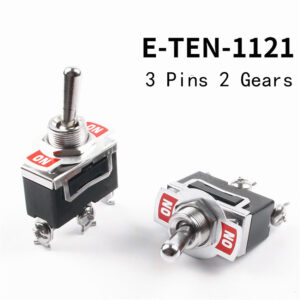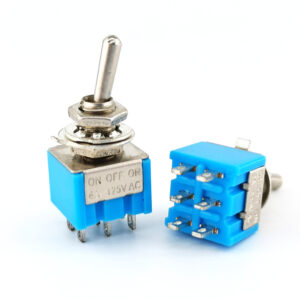1. What are Toggle Switches?
There are many types of switches we can use in our daily lives, and toggle switches are one of them. A toggle switch is a switch that switches a circuit by turning the switch handle on or off. Toggle switches are generally used in low-voltage circuits and have the characteristics of flexible slide action and stable and reliable performance. The following will introduce to you the working principle, types, applications of toggle switches.
2. How Does a Toggle Switch Work?
A toggle switch has a manually operated hinge, handle, or lever mechanism that allows it to be moved from one position to another. Usually, it can be locked in a certain position to achieve an opening and closing effect. In addition, Bulk Switch Marts also produces reset-type toggle switches. When you release your hand, it will return to the initial position to achieve a short-term control effect. If you have any bulk switch needs, please feel free to contact us.
A toggle switch is a switch that controls the on and off of a circuit by interrupting and restoring current. Its working principle is to move the moving contacts through the bumping block on the handle, so that the moving and static contacts contact or separate, thereby realizing circuit control. When the contacts connect, the circuit is closed, electricity can flow, and the connected device will start and operate. When the contacts move away, the current is interrupted, the circuit is broken, and the device shuts down.
3. Toggle Switch Types
There are many types of toggle switches based on different designs and functions to meet various circuit needs and application scenarios. This diversity makes the toggle switch flexible and suitable for various circuit designs. Whether it is a simple switching operation or a more complex circuit switching, you can find the right type to meet the actual needs.
3.1 Classification from the ability to control circuits of the Toggle Switch
Toggle switches usually have the function of switching different devices, so Bulk Switch Marts provides multiple versions of toggle switches with On-O, On-Off and On-Off-On switching functions. Whether you’re looking for a simple on and off operation or need to switch between multiple circuit configurations, we have the toggle switches in our store to meet your needs. We look forward to providing you with high-quality, multi-functional toggle switches.
3.1.1 On-On Toggle Switches
On-On toggle switches have two or more fixed positions that allow switching between these positions. In each position, the contacts of the toggle switch can be connected to a different circuit. This makes it suitable for scenarios requiring a variety of circuit configurations. On-On toggle switches are often used in electronic devices that need to switch between multiple states, such as audio mode selection in audio equipment.
3.1.2 On-Off Toggle Switches
The On-Off switch has only two fixed positions, one is on and the other is off. In the open position, the circuit is connected; in the closed position, the circuit is interrupted. On-Off toggle switches are often used in scenarios that require a simple on and off operation, such as power switches or lighting controls.
3.1.3 On-Off-On Toggle Switches
An On-Off-On toggle switch is a toggle switch that has three fixed positions that allow the user to toggle between these positions. This design allows the toggle switch to switch between two different circuit states. In the first open position, the contacts of the switch are connected to a circuit, allowing current to flow. In the closed position, the contacts break the circuit, causing an interruption in current flow. And in the second open position, the contacts are connected to Another circuit. On-Off-On toggle switches are common in electronic devices, automotive electrical systems, and other applications that require switching between multiple states.
3.2 Classification from the Size of the Toggle Switch
Toggle switches come in many different sizes, and different sizes help it fit in a variety of environments and equipment. Whether it’s a miniature toggle switch for electronic equipment with limited space, or a large toggle switch for industrial machinery, our toggle switches provide users with a range of options to meet the different needs of our customers. We will show some common sizes and specifications of toggle switches.
3.2.1 Sub-Mini Toggle Switch
Sub-mini toggle switches are smaller in size than regular toggle switches. Sub-mini toggle switches are widely used in communication equipment and digital audio and video.

3.2.2. Mini Toggle Switch
The mini toggle switch features a sensitive spring-loaded switch that responds quickly to smaller forces. Mini toggle switches are inexpensive and designed for lower currents. So mini toggle switches are widely used in household and industrial equipment, such as microwave ovens, elevators, vending machines, etc.
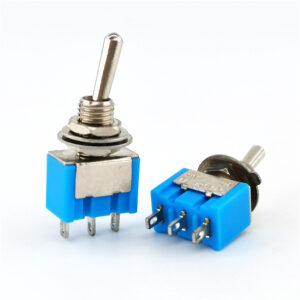
3.2.3. Medium Toggle Switch
Medium toggle switches are well sized and are commonly used in control panels, instrument panels, and other settings where a reliable and well-sized switch is required. Their durable construction ensures medium toggle switch can withstand repeated use, making them a reliable choice for a variety of electrical and electronic systems.

3.3 Classification from the Function of the Toggle Switch
According to different work requirements, different toggle switches will have some special designs. For example, we will introduce these to you below: LED Toggle Switch, toggle Switch with Cover, miniature Rocker Toggle Switches, Flat Toggle Switch, Momentary Toggle Switches
3.3.1. LED Toggle Switch
An LED toggle switch is a toggle switch with a light-emitting diode (LED) on the top. This LED indicates the on or off status of the toggle switch

3.3.2. Toggle Switch with Cover
This type of toggle switch will have a cover or cap on the top. It can be used to protect the tip of an internal switch to prevent the switch from accidentally opening or closing.
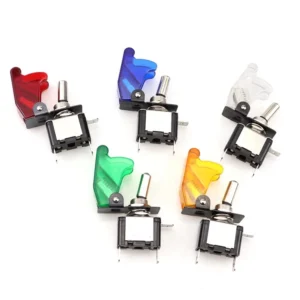
3.3.3. Rocker Toggle Switch
Instead of a traditional lever or flat handle, rocker toggle switches have a unique rocker-shaped actuator. This design allows the user to toggle the switch by pressing one side of the stick. This switch allows the user to easily identify whether a circuit is open or closed.
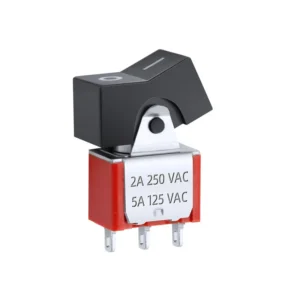
3.3.4 Flat Handle Toggle Switch
A flat handle toggle switch is a special type of toggle switch that is characterized by its flat handle. Unlike traditional toggle switches, the design of the flat handle toggle switch provides a larger area for user interaction and helps to quickly identify the switch position.
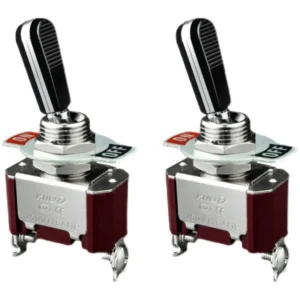
3.3.5 Momentary Toggle Switches
Momentary toggle switches are no different in appearance from other switches. Momentary toggle switches are mainly used to achieve short-term circuit connection or disconnection. When the user turns on the momentary toggle switch, the circuit briefly closes, allowing current to flow. Once the user releases the switch, it quickly returns to its original position, cutting off the circuit.
4. Contact Configuration of Toggle Switches
The main four types of toggle switches are SPDT, SPST, DPDT, and DPST, each with different throw and pole combinations. The electrodes of these switches are usually different power sources controlled by each switch, and the switches can control different zones.
4.1 Single Pole Single Throw (SPST)
SPST stands for single pole single throw. The main job of this switch is to establish or terminate a connection between a conductor and a branch. Once this switch is open, the circuit is cut off, preventing any current from flowing through the load. When the switch is closed, current flows through the load.

4.2 Single Pole Double Throw (SPDT)
SPDT is single pole double throw. The SPDT toggle switch can operate either of the two circuits. It can switch between two circuits. This allows various gadgets or circuits to be energized with the flick of a switch.

4.3 Double Pole Single Throw (DPST)
DPST switch refers to a double switch single throw switch used to establish or terminate a connection between two circuit conductors within a single branch circuit. It usually has four terminals and can be used to connect and disconnect two pairs of terminals at the same time.
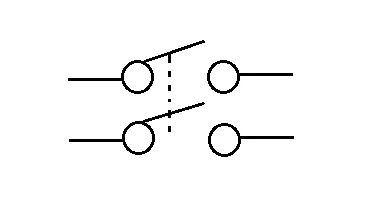
4.4 Double Pole Double Throw (DPDT)
Double pole double throw (DPDT) toggle switches are used to make or terminate connections between two conductors and two different circuits. There are six terminals on these switches, terminal 3 and terminal 4 get the necessary power to drive the load on the other terminals (1, 5, 2 and 6).
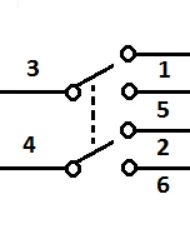
5. Toggle Switch Applications
- Car headlights or similar controls and indicators.
- Conveyor belts, residual current devices and other industrial and electrical equipment
- In household, commercial and industrial power sockets.
- As the main switch of industrial machinery such as conveyors, packaging machines and AC equipment.
- Used for switching headlights, logic level programs, automotive and aviation control panels, etc.
- Used as switching circuits in communications, commercial and industrial equipment.
6. Conclusion
All in all, we hope that by reading this article, you can understand the definition, working principle, various types, different electric contact configurations and applications of toggle switches. If you have any other questions about toggle switches, or if you would like to purchase them in our store, please feel free to contact us.
